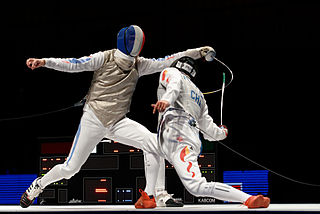
Fencing is a combat sport that features sword fighting. The three disciplines of modern fencing are the foil, the épée, and the sabre ; each discipline uses a different kind of blade, which shares the same name, and employs its own rules. Most competitive fencers specialise in one discipline. The modern sport gained prominence near the end of the 19th century and is based on the traditional skill set of swordsmanship. The Italian school altered the historical European martial art of classical fencing, and the French school later refined that system. Scoring points in a fencing competition is done by making contact with an opponent.

A parry is a fencing bladework maneuver intended to deflect or block an incoming attack.

A foil is one of the three weapons used in the sport of fencing. It is a flexible sword of total length 110 cm (43 in) or under, rectangular in cross section, weighing under 500 g (18 oz), with a blunt tip. As with the épée, points are only scored by making contact with the tip. The foil is the most commonly used weapon in fencing.

The épée, sometimes spelled epee in English, is the largest and heaviest of the three weapons used in the sport of fencing. The modern épée derives from the 19th-century épée de combat, a weapon which itself derives from the French small sword.
The remise is a renewal of an attack in fencing. It is performed when one fencer's attack has failed, either because their opponent has parried or they missed. If the attacker immediately continues their attack in the same line, they have executed a remise. The name also is applied to repetitions of other actions which did not initially succeed. The remise is at the bottom of actions in taking priority.
Classical fencing is the style of fencing as it existed during the 19th and early 20th centuries. According to the 19th-century fencing master Louis Rondelle,
A classical fencer is supposed to be one who observes a fine position, whose attacks are fully developed, whose hits are marvelously accurate, his parries firm, and his ripostes executed with precision. One must not forget that this regularity is not possible unless the adversary is a party to it. It is a conventional bout, which consists of parries, attacks, and returns, all rhyming together.
In fencing, a riposte is an offensive action with the intent of hitting one's opponent made by the fencer who has just parried an attack. In military usage, a riposte is the strategic device of hitting a vulnerable point of the enemy, thereby forcing them to abandon their own attack.

The sabre is one of the three disciplines of modern fencing. The sabre weapon is for thrusting and cutting with both the cutting edge and the back of the blade.

The following outline is provided as an overview of and topical guide to fencing:

In fencing, an attack is "The attack is the initial offensive action made by extending the arm and continuously threatening the opponent’s target, preceding the launching of the lunge or flèche". In order for an attack to be awarded successfully, the fencer must accelerate their hand towards the target. If the fencer does not accelerate the hand, this is a preparation.
Rapier Combat is a style of historical fencing practiced in the Society for Creative Anachronism (SCA). The primary focus is to study, replicate and compete with styles of rapier sword-fighting found in Europe during the Renaissance period, using blunted steel swords and a variety of off-hand defensive items. Participants wear period clothing while competing, along with or incorporating protective equipment for safety. In the April 2020 update of the rules, the sport was renamed 'Fencing Combat'.

The flick is a technique used in modern fencing. It is used in foil and to a lesser extent, épée.
In fencing, the grip is the part of the weapon which is gripped by the fencer's hand.

The flèche is an aggressive attacking technique in fencing, used with foil and épée.
The Amateur Fencers League of America (AFLA) was founded on April 22, 1891, in New York City by a group of fencers seeking independence from the Amateur Athletic Union. As early as 1940, the AFLA was recognized by the Fédération Internationale d'Escrime (FIE) and the United States Olympic Committee as the national governing body for fencing in the United States.
Fencing practice and techniques of modern competitive fencing are governed by the Fédération Internationale d'Escrime (FIE), though they developed from conventions developed in 18th- and 19th-century Europe to govern fencing as a martial art and a gentlemanly pursuit. The modern weapons for sport fencing are the foil, épée, and sabre.

Anja Fichtel-Mauritz is a retired German foil fencer. At the 1988 Summer Olympics in Seoul, she won in the individual and team competitions, and she won the individual competition of the World Championship in 1986 and 1990. She was winner of the World Championships in 1985, 1989, 1993 as a member of the national German team and second in team competition at the 1992 Summer Olympics. From 1986 until 1996 Fichtel held the title of German champion.

Tactics are very important to playing well in modern fencing and although technique is important in the sport, using an array of tactics will help fencers make the most of that technique.
This is a glossary of terms used in fencing.
This article details the qualifying phase for fencing at the 2024 Summer Olympics. The competition will comprise a total of 212 fencers, with an equal distribution between men and women, coming from the different NOCs, similar to the Tokyo 2020 roster size. Qualified NOCs can enter a maximum of eighteen fencers, with each consisting of a trio, whether men's or women's, across all weapon-based team events.










